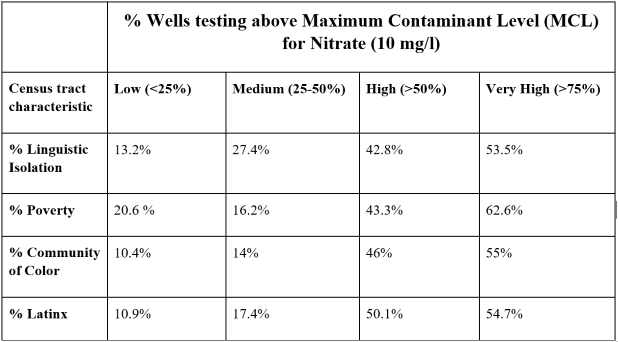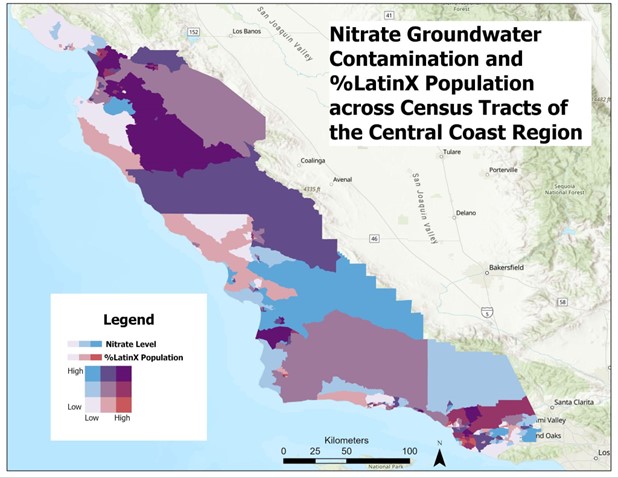Racial Discrimination Complaint Names CA State Water Board As Partly To Blame For Fertilizer Contamination In Central Coast Drinking Wells

PRESS RELEASE
For immediate distribution
March 19, 2024
Media Contacts:
- Elias Rodriguez, California Rural Legal Assistance, Inc., (831) 757-5221, erodriguez@crla.org
- Chelsea Tu, Monterey Waterkeeper, (831) 204-1381, chelsea@montereywaterkeeper.org
Salinas, CA – This week, Latino community groups were joined by Monterey Waterkeeper and the Environmental Justice and Common Good Initiative at Santa Clara University in filing a Civil Rights Complaint with the U.S. Environmental Protection Agency (EPA) against the State Water Resources Control Board (State Water Board). The complaint addressed the racially disproportionate impacts caused by the State Water Board’s failure to regulate water pollution from nitrogen fertilizers used by the agricultural industry in California’s Central Coast region.
According to an analysis of census and well monitoring data completed by Santa Clara University scientists, groundwater in the Central Coast region is 4.4 times more likely to contain nitrate levels above state drinking water standards in Latino communities as compared to non-Latino communities. Further, nitrate levels in Latino communities are likely to be almost 150% higher than those in mostly white communities. Nitrate ingestion in drinking water is especially dangerous for infants and pregnant women as it can cause potentially deadly methemoglobinemia (“blue baby syndrome”). Nitrates can also cause cancer and thyroid disease in adults.
One group filing the complaint has had nitrate contaminated tap water for the last decade. Maria Velasquez, a member of complainant group Misión San Lucas says, “I have been working for 10 years to control the problem of nitrates in our water—for my family, for the students at San Lucas Elementary School, and for all the community. And, today, I am still fighting for this same cause.”
The complainant groups, some of whom are represented by California Rural Legal Assistance, Inc. (CRLA), allege that the State Water Board has acted to prevent the Central Coast Regional Water Quality Control Board (Regional Board) from placing enforceable fertilizer limits in agricultural permits–an action likely to cause significant disparities in water contamination for Latino communities in the region. Groups allege that the history of racial discrimination affecting Latino farmworkers in the region makes Latino and immigrant communities far more likely to have contaminated water supplies.
California’s Human Right to Water Act establishes the state policy that every human being has the right to safe, clean, affordable, and accessible water. Despite this law, nitrates from fertilizer application in farming communities contaminate thousands of drinking water wells.
The State Water Board’s Racial Equity Resolution acknowledges that “race predicts a person’s access to governmental services and the quality and affordability of the services they receive,” including the “availability of safe drinking water”, and that “race is the strongest predictor of water access” in California. The U.S. EPA is required to prevent programs it funds from allocating resources or burdens in a discriminatory manner, under Title VI of the Civil Rights Act and its own implementing regulations.
CRLA is a rural, legal aid organization that got its start in the 1960s working alongside Dolores Huerta and Cesar Chavez on behalf of farmworkers dealing with excessive pesticide use and other harms. In the present action, CRLA is joined by Hydrologists/Data Scientists Iris-Stewart Frey and Jake Dialesandro (Santa Clara University) and a local water protection group in partnering with Latino community groups and farmworkers to address the water contamination that is caused by growers using excess fertilizer that cannot be absorbed by crops.
“The State Water Board talks about racial equity, but again and again places farmers’ profits and convenience over Latino communities’ drinking water,” says Chelsea Tu, Executive Director for Monterey Waterkeeper. Tu says, “It’s time for the Board to take action and protect the health of vulnerable communities.”
Elias Rodriguez, a staff attorney with CRLA comments, “Ask yourself this: Is the water that comes out of my tap drinkable? In the Central Coast, the answer to that question is predicted by a person’s race. A person’s racial identity should not predict the safety of their water. That is not acceptable, just, or equitable. It’s an environmental injustice.”
Some of the groups joining the complaint participated in the State Water Board’s review of the Central Coast Regional Board’s 2021 Agricultural Order—which was a first-of-its-kind effort to try to curb the over-application of synthetic nitrogen fertilizers by setting numeric limits on fertilizer use and discharge. In September of last year, complainant groups commented that the State Water Board’s removal of the Regional Water Board’s fertilizer application and discharge limits would have a disproportionate effect on Latino communities. Communities urged the State Water Board to maintain the limits. Despite their comments, the State Water Board instructed the Regional Board to remove enforceability of the limits until a date yet certain.
Complainants have requested that the U.S. EPA immediately and thoroughly investigate the State Water Board’s noncompliance with Title VI of the Civil Rights Act related to its actions and inactions on its agricultural regulations and are requesting that the State Water Board, by a date certain, set enforceable limits for the application and discharge of nitrogen into groundwater to protect the public health of all Californians.
###

Table 1: Percentage of domestic wells, where average nitrate concentrations (2010-2023 GAMA Database) in shallow (<=200 ft) wells are above the MCL (10 mg/l) for census tracts with different characteristics
In census tracts where linguistic isolation, poverty, and the percent of Latinx and non-white populations are high (above 75%), average nitrate concentrations are above the MCL in more than half of the shallow wells. By contrast, in census tracts where linguistic isolation, poverty, and the percent of Latinx and non-white populations are low (below 25%), average nitrate concentrations are above the MCL in less than one quarter of the shallow wells. Thus, nitrate concentrations are higher in census tracts with predominantly Latinx populations or Communities of Color.

Map: Percentage of Latinx Population by Census Tract and Ambient Groundwater Nitrate Levels (2010-2023) in the Central Coast region
Data Source: Groundwater Ambient Monitoring and Assessment (GAMA) Program and CalEnviroScreen Data (OEHHA)

